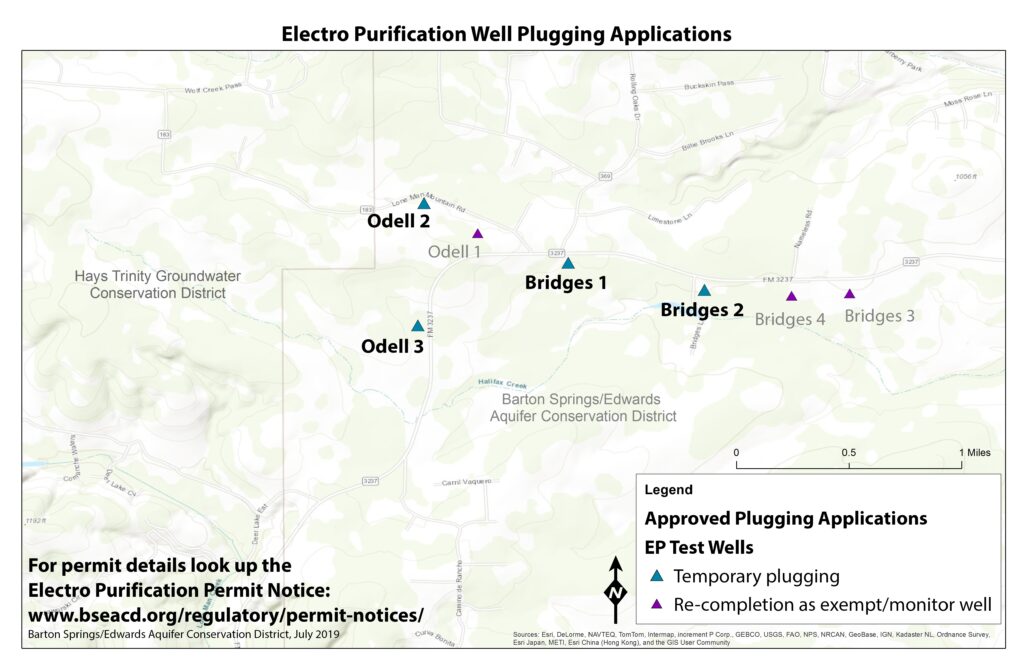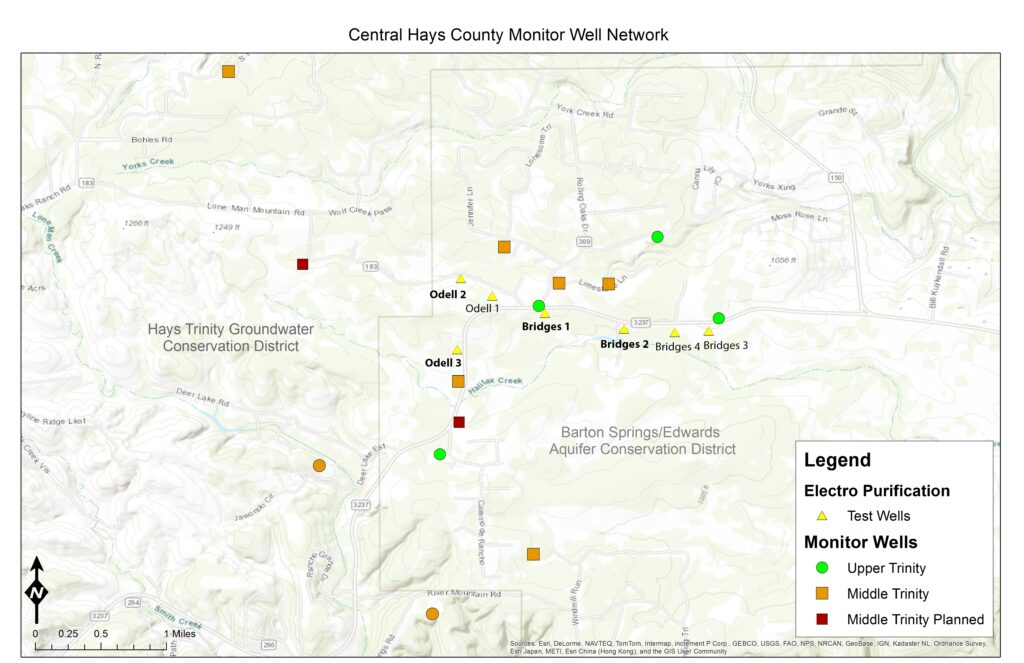There has been significant progress on a number of topics regarding central Hays County groundwater, and the District felt an update was in order. In this Spotlight, you’ll find updates on the Electro Purification (EP) test well plugging permits, the EP contested case, central Hays County monitor well network, and numerical model development.
EP Test Well Plugging Permits
On May 10, 2019, Electro Purification submitted seven well plugging applications to bring the existing test wells into compliance with state and Barton Springs Edwards Aquifer Conservation District (District) well construction standards. Four of the test wells will be temporarily plugged and the remaining three will be permanently re-completed as exempt and/or monitor wells. This plugging and re-completion work is anticipated to begin on July 15, 2019. Additional information is available on the EP Permit Notice page.

- Bridges 1 – To be temporarily plugged as an Upper Glen Rose well. May be re-completed in the future as public water supply if a production permit is issued by the District.
- Bridges 2 – To be temporarily plugged as an Upper Glen Rose well. May be re-completed in the future as public water supply if a production permit is issued by the District.
- Bridges 3 – To be permanently re-completed as an exempt Upper Glen Rose well.
- Bridges 4 – To be permanently re-completed as an exempt Lower Glen Rose well.
- Odell 1 – To be permanently re-completed as an exempt Lower Glen Rose well.
- Odell 2 – To be temporarily plugged as a Lower Glen Rose well. May be re-completed in the future as public water supply if a production permit is issued by the District.
- Odell 3 – To be temporarily plugged as a Lower Glen Rose well. May be re-completed in the future as public water supply if a production permit is issued by the District.
EP Production Permit Contested Case – hearing schedule modification
The EP Production Permit contested case is ongoing. Once a permit decision is made after the contested case process, EP will need to meet permit provisions before production begins. A significant number of exhibits, pre-filed testimonies, and motions have been filed by the applicant, protestant, and the District. The State Office of Administrative Hearings posts submitted documents and decisions made by the Administrative Law Judge (ALJ) on their web portal. Use the Public Case File Search to search for Docket # 957-18-4985. Select the icon on the left to view the documents associated with the contested case.
On May 30, 2019, the District released updated special provisions to the draft EP Production Permit based on stakeholder discussions, mediation, and additional staff research. On June 26, 2019, EP and TESPA asked to modify the hearing schedule to allow them time to adjust their testimonies to address the updated special provisions. The District had no objection to the modified hearing schedule. On July 2, 2019, the ALJ granted the modified schedule, reset the prehearing conference to April 24, 2020 at 10:00 am, and reset the hearing on the merits to convene at 9:00 am on April 27, 2020 through May 5, 2020, at the State Office of Administrative Hearings, 300 W. 151h Street, Fourth Floor, Austin, Texas.
Central Hays County Monitoring Network
 The District continues to expand the Trinity Aquifer monitoring network in central Hays County. Currently, there are 12 wells equipped with pressure transducers that measure continuous water levels. Staff continues to collect data from 12 independent sampling zones in the central Hays Co. multiport well on Limestone Lane and is testing the feasibility of using sonic water-level loggers to expand the monitoring network without having to recomplete existing wells. Additionally, the District is collaborating with the Hays Trinity Groundwater Conservation District to drill and equip an additional Middle Trinity to the west of the EP wells on Lone Man Mountain Rd. and with Hays County to drill a sophisticated multiport monitor well to the south of the EP wells on FM 3237. Over 100 private wells in the area have been monitored and sampled over the past four years.
The District continues to expand the Trinity Aquifer monitoring network in central Hays County. Currently, there are 12 wells equipped with pressure transducers that measure continuous water levels. Staff continues to collect data from 12 independent sampling zones in the central Hays Co. multiport well on Limestone Lane and is testing the feasibility of using sonic water-level loggers to expand the monitoring network without having to recomplete existing wells. Additionally, the District is collaborating with the Hays Trinity Groundwater Conservation District to drill and equip an additional Middle Trinity to the west of the EP wells on Lone Man Mountain Rd. and with Hays County to drill a sophisticated multiport monitor well to the south of the EP wells on FM 3237. Over 100 private wells in the area have been monitored and sampled over the past four years.
Blanco River Trinity Aquifer Numerical Model
District staff are working with the Meadows Center, Edwards Aquifer Authority, Hays-Trinity Groundwater Conservation District, Blanco-Pedernales Groundwater Conservation District, and Southwest Research Institute on a technical committee to compile data and establish a framework for a numerical model of the Trinity Aquifers in central Hays County. This model will help us better understand groundwater resources in the Blanco River basin and the interactions between the Trinity Aquifers and the Blanco River.
